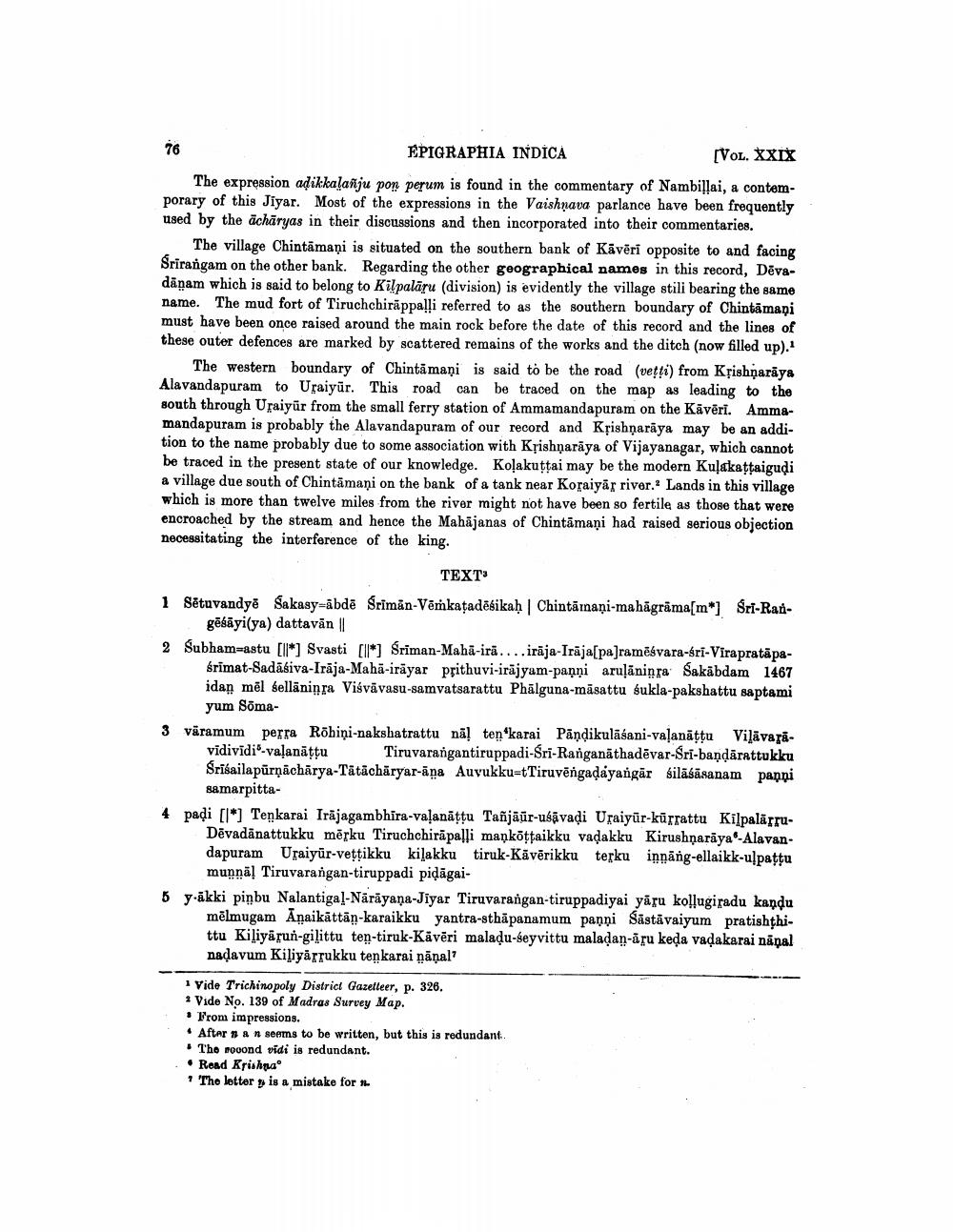________________
76
EPIGRAPHIA INDICA
[VOL. XXIX
The expression adikkalañju pon perum is found in the commentary of Nambillai, a contemporary of this Jiyar. Most of the expressions in the Vaishnava parlance have been frequently used by the acharyas in their discussions and then incorporated into their commentaries.
The village Chintamani is situated on the southern bank of Kāvēri opposite to and facing Srirangam on the other bank. Regarding the other geographical names in this record, Devadāṇam which is said to belong to Kilpalāru (division) is evidently the village stili bearing the same name. The mud fort of Tiruchchirappalli referred to as the southern boundary of Chintamani must have been once raised around the main rock before the date of this record and the lines of these outer defences are marked by scattered remains of the works and the ditch (now filled up).1
The western boundary of Chintamani is said to be the road (vetti) from Krishnaraya Alavandapuram to Uraiyur. This road can be traced on the map as leading to the south through Uraiyur from the small ferry station of Ammamandapuram on the Kāvēri. Ammamandapuram is probably the Alavandapuram of our record and Krishnaraya may be an addition to the name probably due to some association with Krishnaraya of Vijayanagar, which cannot be traced in the present state of our knowledge. Kolakuṭṭai may be the modern Kulakaṭṭaiguḍi a village due south of Chintamani on the bank of a tank near Koraiyar river. Lands in this village which is more than twelve miles from the river might not have been so fertile as those that were encroached by the stream and hence the Mahajanas of Chintamani had raised serious objection necessitating the interference of the king.
TEXT
1 Sétavandy Sakasy-abde Sriman-Vishkajadiéikab | Chintamani-mahägrama[m] Sri-Radgēsāyi(ya) dattavan ||
2 Subham-astu [*] Svasti [*] Śrīman-Mahā-irā....irāja-Iraja[pa]ramēśvara-sri-Virapratāpaśrīmat-Sadasiva-Iraja-Maha-irayar prithuvi-irajyam-panni arulāniņra Sakabdam 1467 idan měl selläninra Viśvāvasu-samvatsarattu Phalguna-masattu śukla-pakshattu saptami yum Sōma
3 vāramum perra Rohini-nakshatrattu na ten karai Pāṇḍikulāśani-valanaṭṭu Vilävaravidivīdis-valanāṭṭu Tiruvarafgantiruppadi-Sri-Ranganathadivar-Sri-bandarattukku Seikailapärpicharya-Tatacharyar-Ana Auvakku-tTiravêngadayagar tilään pai
samarpitta
4 padi [1] Tenkarai Irkjagambhira-valandṭṭu Tañjade-usävadi Ursiyür-kürrattu KilpalärruDevadānattukku mērku Tiruchchirapalli mankōṭṭaikku vadakku Kirushnaraya"-Alavandapuram Uraiyur-veṭṭikku kilakku tiruk-Kāvērikku terku innäng-ellaikk-ulpaṭṭu munnal Tiruvarañgan-tiruppadi pidäga
5 yakki pisbu Nalantigal-Narayana-Jiyar Tiruvarangan-tiruppadiyai yara kollugiradu kandu melmugam Anaikättän-karaikka yantes-sthapanamum panni Sastavaiyum pentishshi ttu Kiliyarun-gilittu ten-tiruk-Kävēri malaḍu-seyvittu malaḍan-aru keda vaḍakarai napal naḍavum Kiliyārrukku tenkarai ṇāṇal'
1 Vide Trichinopoly District Gazetteer, p. 326.
* Vide No. 139 of Madras Survey Map.
From impressions.
After na n seems to be written, but this is redundant.
The rooond vidi is redundant.
• Read Krishna
The letter is a mistake for n




